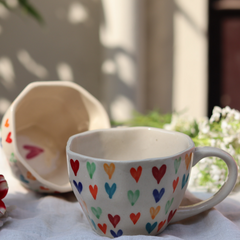Gudi Padwa, also known as Ugadi in some regions, is a spring festival celebrated by people in the Indian states of Maharashtra, Karnataka, and Telangana, as well as in some other parts of India. It marks the beginning of the traditional Hindu New Year and is observed on the first day of the Chaitra month according to the Hindu lunisolar calendar, which usually falls in March or April.
The word "Gudi" refers to a flag or banner, which is hoisted on this day in front of houses as a symbol of victory and celebration. It is usually made by tying a bright cloth (usually yellow or green) to a bamboo stick, along with decorations like flowers, neem leaves, and sugar crystals. This is then placed at the entrance of homes.
The festival is celebrated with various rituals and traditions, including cleaning and decorating homes, preparing special dishes like puran poli (a sweet flatbread), participating in cultural events, and exchanging greetings and gifts with family and friends.
Gudi Padwa is significant not only for its cultural and traditional importance but also for its agricultural significance, marking the beginning of the harvest season and the arrival of spring. It symbolizes new beginnings, prosperity, and the triumph of good over evil. 
Gudi Padwa is celebrated for several reasons, both cultural and historical:
-
New Year: Gudi Padwa marks the beginning of the traditional Hindu New Year. It falls on the first day of the Chaitra month, which is the first month of the Hindu lunisolar calendar. It symbolizes the start of a new year filled with hope, prosperity, and happiness.
-
Harvest Festival: Gudi Padwa also holds significance as a harvest festival. It marks the onset of the harvest season, particularly for crops like sugarcane and wheat. Farmers celebrate the festival by expressing gratitude for the successful harvest and praying for a bountiful season ahead.
-
Cultural Significance: Gudi Padwa is deeply rooted in Indian culture and tradition. It is celebrated with various rituals and customs that have been passed down through generations. These rituals include cleaning and decorating homes, wearing new clothes, preparing special dishes, and performing puja (prayers) to seek blessings for the new year.
-
Historical and Mythological Events: According to Hindu mythology, Gudi Padwa commemorates several significant events. One such event is the return of Lord Rama to Ayodhya after his victory over the demon king Ravana, as narrated in the epic Ramayana. It is believed that people in Ayodhya celebrated Rama's return by hoisting flags (Gudi) as a symbol of victory.
-
Astrological Significance: Gudi Padwa also holds astrological significance as it marks the beginning of the spring equinox. It is believed that the positioning of celestial bodies during this time has a favorable influence on new beginnings, making it an auspicious time for starting new ventures and endeavors.
Overall, Gudi Padwa is celebrated as a joyous occasion that symbolizes renewal, prosperity, and the triumph of good over evil. It brings families and communities together to celebrate the spirit of togetherness and optimism for the year ahead.
Traditional Maharashtrian Dishes for Gudi Padwa:-
Gudi Padwa lunch typically consists of a delicious spread of traditional Maharashtrian dishes along with other festive treats. Here's a sample menu of what a Gudi Padwa lunch might include: 
-
Puran Poli: This is a sweet flatbread made from wheat flour, stuffed with a mixture of cooked lentils (usually chana dal), jaggery, and spices like cardamom and nutmeg. It's a quintessential Gudi Padwa delicacy.
-
Aamras: Aamras is a sweet mango puree, usually served chilled. It's made by blending ripe mangoes with sugar or jaggery and flavored with a hint of cardamom.
-
Kothimbir Vadi: These are savory fritters made from chickpea flour (besan) mixed with finely chopped coriander leaves (kothimbir), spices, and sometimes grated coconut. They are steamed or fried until crispy and served as an appetizer or side dish.
-
Batata Bhaji: A simple yet delicious potato curry cooked with mustard seeds, turmeric, chili powder, and other spices. It's a common accompaniment to puran poli and is enjoyed with steamed rice or chapatis.
-
Shrikhand: Shrikhand is a creamy dessert made from strained yogurt (hung curd), sugar, and flavored with saffron, cardamom, and sometimes nuts like almonds or pistachios. It's served chilled and makes for a refreshing end to the meal.
-
Papad: Crispy papads (thin, seasoned flatbreads made from lentil or rice flour) are often served as a crunchy side dish to complement the flavors of the main course.
-
Rice: Steamed white rice is a staple accompaniment in many Maharashtrian meals. It pairs well with the spicy curries and lentil dishes.
-
Aam Panna: Aam Panna is a refreshing summer drink made from raw mangoes, sugar, and spices like roasted cumin and black salt. It's served chilled and is believed to have cooling properties.

This is just a sample menu, and the actual dishes served may vary depending on regional preferences and family traditions. However, these are some common and popular choices for a Gudi Padwa lunch, reflecting the festive spirit and culinary richness of the occasion.
Conclusion:-
In conclusion, Gudi Padwa is a vibrant and culturally significant festival celebrated primarily in the Indian states of Maharashtra, Karnataka, and Telangana, marking the beginning of the traditional Hindu New Year. It is observed with great enthusiasm and joy, symbolizing renewal, prosperity, and the triumph of good over evil. During Gudi Padwa, families come together to clean and decorate their homes, wear new clothes, and prepare delicious traditional meals. Special dishes like puran poli, aamras, kothimbir vadi, and shrikhand are enjoyed, along with other festive treats.



